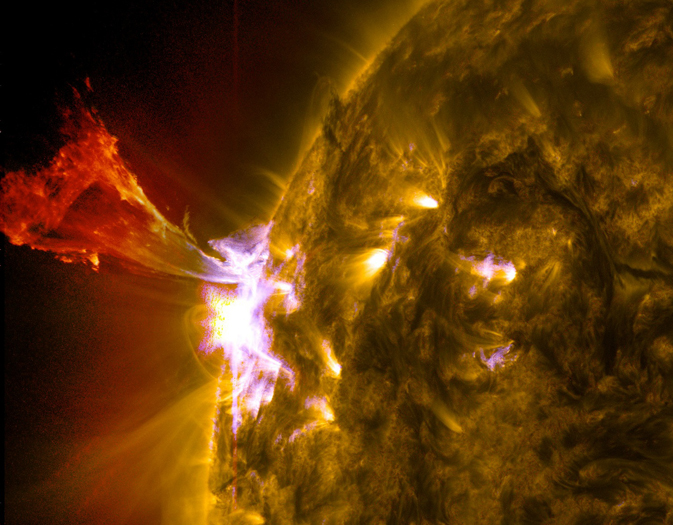Extreme Solar Storm Could Cause Widespread Disruptions on Earth

WASHINGTON — If an extreme solar storm aimed at the Earth hits in just the right way, it could put interconnected electrical grids around the world at serious risk, experts say.
In addition to creating beautiful auroras, extreme solar storms could knock out a wide range of electric utilities needed to keep life in the United States and around the world functioning normally, according to presenters here at the fourth annual Electric Infrastructure Security Summit.
"What [a solar storm] can do — even if it isn't causing a continental-scale outage — it can really cause a regional blackout," said Daniel Baker, director of the Laboratory for Atmospheric and Space Physics at the University of Colorado. "Imagine something like, for example, Superstorm Sandy. Imagine that kind of severe storm — but causing regional outages for weeks. Living without power really cascades and propagates in remarkable ways throughout our society." [The Worst Solar Storms in History]
As the sun reaches the peak in its 11-year cycle this year, scientists expect that active regions of the star — known as sunspots — will erupt, flinging streams of charged particles out into the solar system. Relatively minor storms can also create temporary radio blackouts and disrupt GPS navigation.
However, this doesn't necessarily mean that all solar eruptions will impact the Earth. Most coronal mass ejections are not aimed toward the planet, and instead shoot out harmlessly into other parts of the solar system. But once every century or so, an extreme solar storm is expected to impact the Earth, Baker told SPACE.com.
The last documented solar storm in this category is known as the Carrington event. Particles from a powerful coronal mass ejection overloaded telegraph wires, setting paper messages on fire in 1859.
These kinds of storms from the sun are notoriously difficult to predict. Experts understand the general conditions under which solar storms occur, but it's hard to forecast just how powerful the storm will be, said Karel Schrijver, a solar scientist and fellow at Lockheed Martin.
Get the Space.com Newsletter
Breaking space news, the latest updates on rocket launches, skywatching events and more!
"A [coronal mass ejection] takes two to four days to get to the Earth, so if we had more observational resources, to map its motion — and if we had some measurements of the structure of what's going to hit you — there are ways by which we can certainly improve the forecast," Schrijver told SPACE.com.
Scientists can use sun-observing satellites like NASA's Solar Dynamics Observatory to monitor, and possibly forecast, solar weather that could be heading toward the planet, Schrijver said.
"There's a lot of space to be explored in terms of computer models that are becoming ever more powerful," Schrijver added. "The heliophysics division at NASA has a wonderful fleet of observatories that looks at the space between the sun and the Earth and the Earth's environment."
Follow Miriam Kramer @mirikramer and Google+. Follow us @Spacedotcom, Facebook and Google+. Original article on SPACE.com.
Join our Space Forums to keep talking space on the latest missions, night sky and more! And if you have a news tip, correction or comment, let us know at: community@space.com.

Miriam Kramer joined Space.com as a Staff Writer in December 2012. Since then, she has floated in weightlessness on a zero-gravity flight, felt the pull of 4-Gs in a trainer aircraft and watched rockets soar into space from Florida and Virginia. She also served as Space.com's lead space entertainment reporter, and enjoys all aspects of space news, astronomy and commercial spaceflight. Miriam has also presented space stories during live interviews with Fox News and other TV and radio outlets. She originally hails from Knoxville, Tennessee where she and her family would take trips to dark spots on the outskirts of town to watch meteor showers every year. She loves to travel and one day hopes to see the northern lights in person. Miriam is currently a space reporter with Axios, writing the Axios Space newsletter. You can follow Miriam on Twitter.









